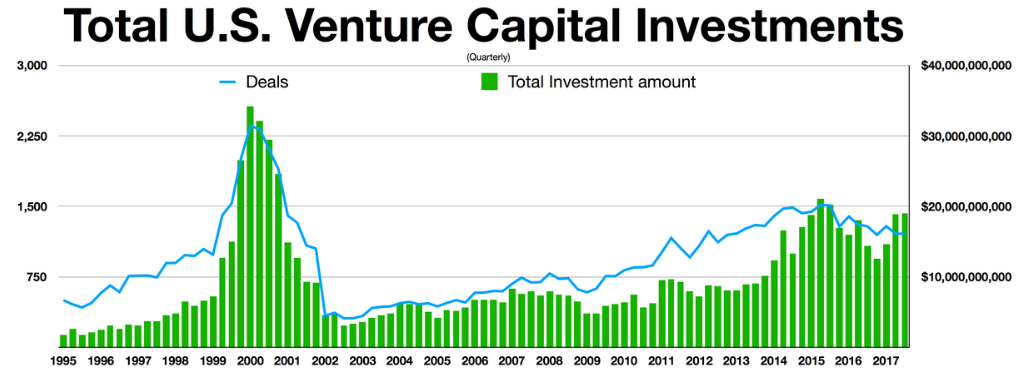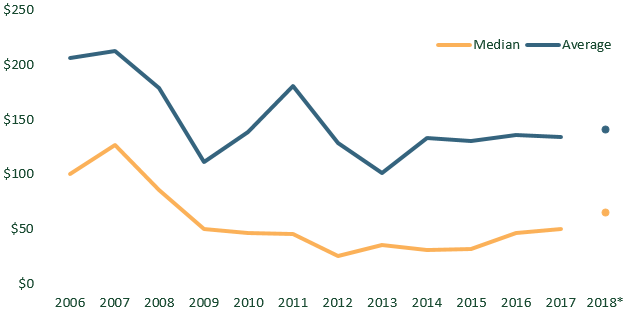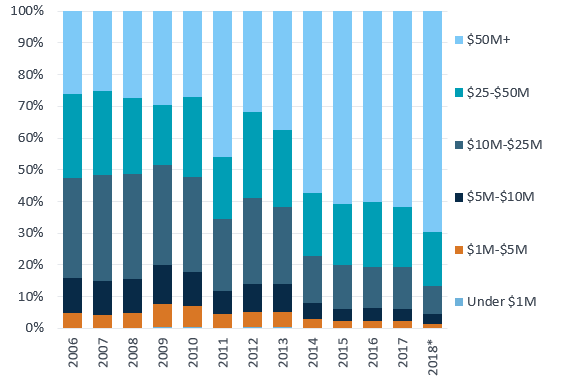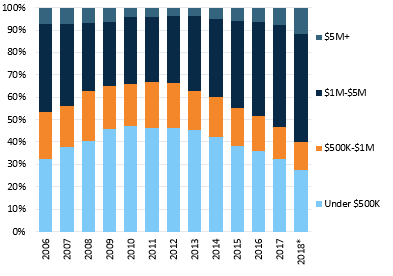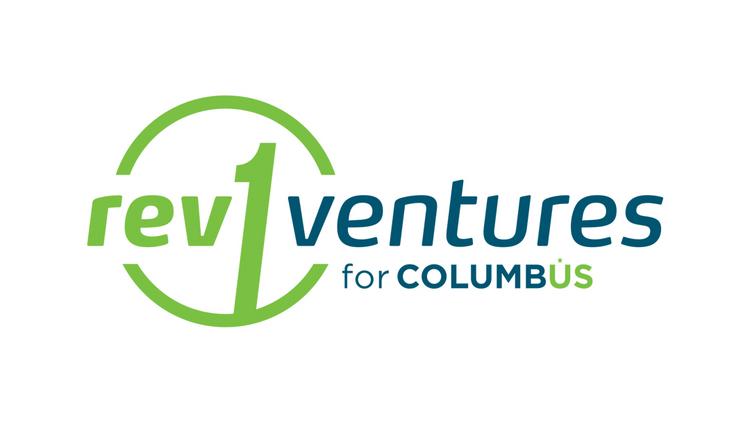Ever since I started in my new role as an Analyst at Rev1 Ventures, I have been intending to write a post detailing my experience trying to break into the world of venture capital. VC is a notoriously difficult sector to make your way in to, especially junior roles for someone only a couple years out of college. A common refrain that you will hear during informational interviews is that there are more professional baseball players than there are venture capitalists. This fact may be overblown (and certainly compares apples to oranges), but it does demonstrate just how difficult it can be to get into the field. Many arguments can be made as to exactly why this is, but at the end of the day, it boils down to a lot of people vying for relatively few open positions.
I was able to make the transition because I made a plan and executed on that plan. There are things I would've done differently, but I think the fact that I was able to make it to final round interviews at 4 different firms demonstrates that my planning was effective.
One of the first things you learn as you start exploring a career path in VC is that the world of venture is filled with people that are willing to take time to help someone along their journey. Hopefully, some of the insights I have learned can be a resource for other people trying to make their way into the big leagues.
Fake it till you make it
The biggest piece of advice I can give to someone trying to get into the world of venture capital, and the place where I think I did the best job in my process, is to fake it till you make it. This means that even before you start working in VC, you should start acting like a venture capitalist. Working in private equity at The Carlyle Group, I knew I was in a related field and at a blue-chip firm that would help get my foot in the door (which it definitely did, but I was on my own past that point), but I also knew that my day-to-day at Carlyle was nothing like what my day-to-day would be like working at a venture capital firm. At Carlyle, I was dealing with billion-dollar transactions that involved decades-old companies, compared to early-stage venture capital where companies may or may not even have a product in the market and any financial records are slim at best. This meant that I had to take it upon myself to demonstrate that I had what it took to be successful in venture.
You are reading the first way I did this. I started this blog for a variety of different reasons, but one of the main ones was so that I could build a "thought-record" for recruiting firms to look at and see that I had put time and effort into thinking critically about startups and the tech ecosystem. My write-ups on specific startups and my sector thesis deep-dives also gave me something to talk about in interviews. This may seem contrived, but if there is one piece of advice you take away from this post, START A BLOG. To be fair, it doesn't have to be a blog per se, but if you are interested in getting into the world of investing in startups, you need to start creating some sort of content that demonstrates you have spent time thinking critically about, you guessed it, investing in startups. (sidenote: I think this advice is applicable for anyone looking to change fields. Get out there and start creating content around where you want to GO, not where you are right now) I chose to blog because I had some limited (and angst-ridden) experience blogging in my high school days, I wanted to get better at writing, and, as a fan of many blogs, I felt like I had a good idea for what other readers would enjoy. Content creation takes work and commitment. No doubt about it. Before you toss aside this idea as not being worth the effort, you should know that the other analyst that I work alongside at Rev1 also started a blog as a way to help get into the industry. Must just be a coincidence...
The other way that I started acting like a VC was through angel investing. Now, I do not have the capital to qualify as an accredited investor (generally a requirement for angel investing), but I am fortunate enough that my father does and was interested in trying something new (he is in private equity, so investing isn't new, but investing in tech startups was). We read Angel (a book about angel investing by one of the best angels in the business), joined angel syndicates on sites like AngelList and Funder's Club, and were off to the races. I helped my dad analyze startup investment opportunities and was able to practice doing some of the things I now do in my job such as writing investment memos, developing front-end deal flow, and portfolio management. This experience of actually practicing some of the skills that I hoped to one day be performing professionally was absolutely invaluable. It gave me something to talk about in interviews and I believe it helped me to stand apart from the crowd of other would-be venture capitalists. I was lucky that I was able to get some exposure to this world by working with my dad, but you can still get this practice without a connection to an accredited investor. Sites like SeedInvest and WeFunder offer even unaccredited investors opportunities to invest in startups. You actually don't even need to make investments. You can sign up for these sites and just look at deals without making any actual investments. Maybe start a shadow portfolio where you track what investments you would've made and how they performed. If you see something especially promising that fits a firm's investment thesis, send it to the attention of a VC you have met through networking. It might not be something they invest in, but if it is thoughtful and fits their firm's investment guidelines, I have never met a VC that wouldn't be impressed.
Whenever you are trying to make a career change into a field different from where you have tangible experience, you need to take it upon yourself to find a way to get exposure outside of your normal working hours. This is especially true in as competitive and nuanced a field as venture. Come up with a way to demonstrate that you are being thoughtful about whatever space you are interested in jumping into. Go to industry-specific events and meetups and connect with people that are actually doing the work you want to be doing. However you want to approach it, faking it till you make it will give you a leg up on landing the role you want.
Take advantage of the resources that are out there
There are a ton of excellent resources on venture capital that you should be immersing yourself in if you want to work in the space. Below I have listed a few of my favorites.
Podcasts
20 Minute VC - An awesome and bite-sized way to get smarter on the "wonderful world of venture capital". In each episode, Harry Stebbings interviews a venture capital investor or startup founder in about twenty minutes. I really enjoy this podcast and Harry is a super nice guy that was kind enough to be a resource to me during my job search.
Invest Like The Best - This podcast hosted by Patrick O'Shaughnessy is my absolute favorite podcast. It covers a wide variety of topics including investing of all types, as well as ways to lead a better and more productive life. The podcasts on venture capital are a great resource, but my favorite episodes are the ones that have nothing to do with investing at all. Patrick also has done a great intro to crypto series that is an awesome first step into that world.
How I Built This - This NPR podcast with Guy Raz is a super interesting and entertaining exploration about how entrepreneurs and business leaders built the companies they are famous for. Not every company explored was a venture-backed startup, but I have found interesting insights about the entrepreneurial journey in every single episode.
a16z Podcast - Andreessen Horowitz's podcast is my favorite firm-sponsored podcast. They mostly showcase topic or sector deep dives from various a16z speaker events. Definitely a great way to get smarter on specific sectors.
Angel: The Podcast - Jason Calacanis' podcast accompaniment to his previously-mentioned book on angel investing. Excellent interviews with both angel and institutional venture capital investors. Jason hasn't done an episode of Angel in a while, but he is also the host of This Week In Startups which is very good.
Websites
avc.com - The definitive venture capital blog by the grandmaster of venture capital, Fred Wilson. Fred publishes a new blog every single day and is a surefire source of wisdom about both life and investing.
John Gannon's Blog - The go-to source for anyone trying to break into venture capital. John's site lists helpful resources as well as a constantly updated source of open positions at venture capital firms.
TechCrunch - Cliche I know, but if TechCrunch is my favorite of the big tech news sites (others being VentureBeat, Recode, Hacker Noon etc) and somewhere I check at least once a day to get a view of what is going on in the ecosystem at large.
Feld Thoughts - Brad Feld of Foundry Group is another one of the big-name investors in the space and his blog is a great resource on the ecosystem. He has also written some must-read books for anyone interested in venture investing like Venture Deals.
Newsletters
StrictlyVC - A venture-only daily newsletter that covers the biggest stories and latest investments in venture.
Axios Pro Rata - Dan Primack's daily blast of the latest news in business and politics.
Fortune Term Sheet - Another great newsletter written by Polina Marinova that covers a wide swath of the latest news in business.
Network your socks off
Does networking matter?
Yes.
Moving on.
But seriously, networking is a key part of any venture capital job search. The reality is that at most firms, networking will be a relatively significant aspect of most junior roles. If you can't network your way to decision makers at firms, how will you ever be able to network your way into meeting the best and brightest founders? To be honest, networking did not come naturally to me either when I first started my process. When I thought of networking, I thought of the overly-eager undergrad business students that would suck-up to anyone and everyone. I thought I was better than that. But I was so wrong about what exactly networking really was. It finally clicked for me when one of my colleagues described networking as meeting new people and hearing about their stories. I am an outgoing guy that enjoys meeting new people and making new friends and thinking of networking through this new lens helped it to really click for me and turned it from something I looked down on (and if I am being honest was anxious about doing) into something that I actually enjoyed. Now it is not all rainbows and butterflies. It is a skill that you need to practice like any other and it can be hard work. But like other skills, you will improve on it as you do it more and more. Networking through informational interviews with current venture capitalists is a great way to expand your network, learn more about specific firms/sectors of the venture ecosystem, and get your foot in the door.
Getting into venture isn't solely about networking, but it is an important aspect of any job search. For reference, 3 out of the 4 final round interviews I had with firms came about because of networking. BUT I ended up taking a job at the one firm where the opportunity came from me responding to a job-listing online. I think my experience is a great demonstration of just how important networking can be, but also how it isn't the end all be all.
Be flexible
Have you gotten the impression of how difficult it can be to make it into the industry yet? If I have not made it clear, let me do so again. Something something more baseball players than VCs something something small number of job openings something something a lot of people trying to get into the space something something 4 partners for every 1 junior level person.
You get the picture. Unless you have been part of a successful start-up, it will be difficult to get hired as a junior level person in the space. A way that you can mitigate this difficulty somewhat is by being flexible.
This doesn't mean apply for anything and everything in the space (though that is a legitimate strategy). Instead, pick one or two characteristics that are really important and be flexible on others.
I was very certain that I wanted to work at an early stage pre-seed/seed firm. I wanted to work with companies at the earliest level and really get in the weeds working alongside entrepreneurs. Because early-stage was a must for me, I decided to be more flexible on other things like where the firm was located.
Let me tell you, when I started my search a year ago, I did not expect that I would be writing this blog post from Columbus, Ohio! Being flexible will open up more opportunities for you and you just may end up falling in love with a place you never expected like my wife and I have with Columbus!
Why VC
Now that I have given you my playbook for getting into VC, you should step back and ask yourself if this is really the sector you want to be in. I can personally attest that it is not as glamorous as Techcrunch headlines would cause you to believe. There is a ton of hard work and grinding. The feedback loop for success is very long and for failure it is jarringly abrupt. If you are motivated strictly by financial upside you are better off going to Wall Street.
But for the right kind of person it is absolutely awesome!
I love what I do. I believe venture capital is a service industry whose customers are your founders and I love working alongside brilliant and motivated entrepreneurs to build game-changing companies. I am excited to go into work every day and gone are feelings of anxiety on Sunday nights. I love getting up to speed on new companies and learning about technologies that I didn't even know existed the day before. I love creatively solving problems and brainstorming ways for founders to run through the walls in their way. I love helping to build an ecosystem and I love working alongside people that are just as passionate as I am.
If venture still sounds like the place for you, give me a call (or reach out to me on twitter).
I'll be your first informational interview.




